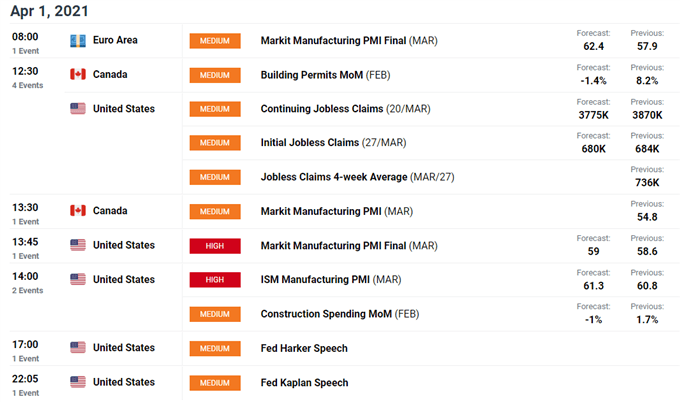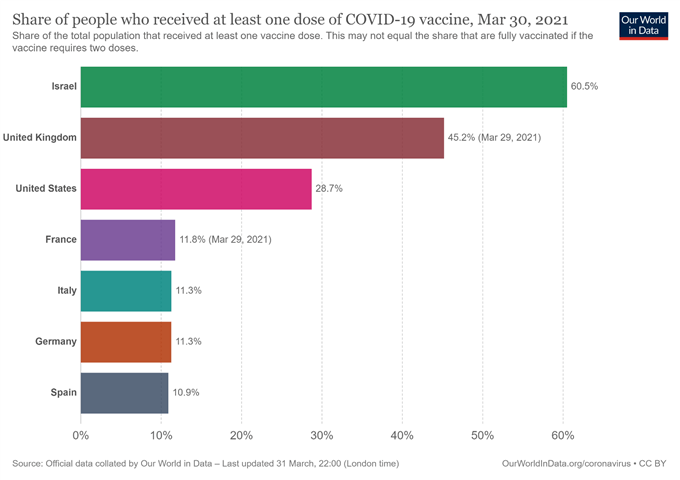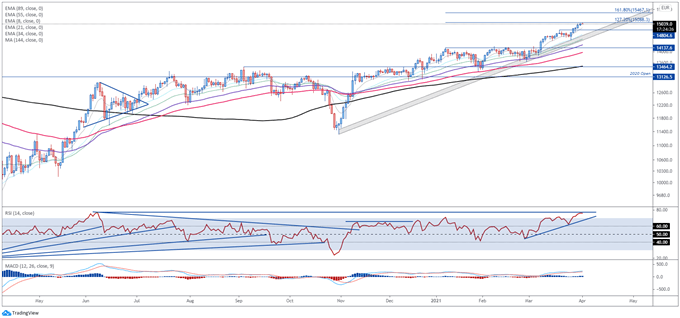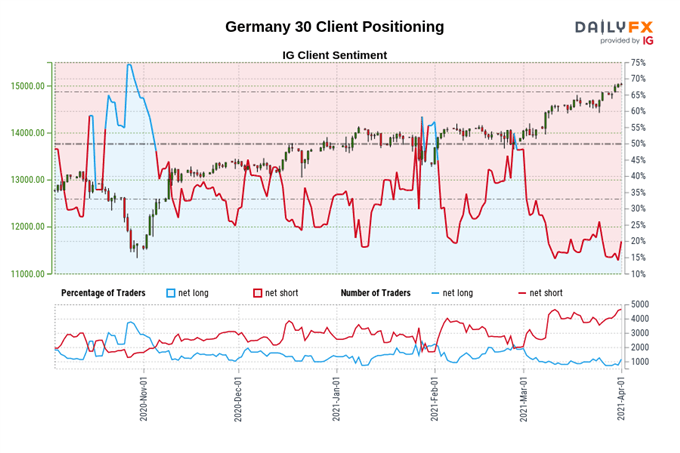DAX 30, EU Recovery Fund, AstraZeneca Vaccine, Coronavirus Cases, Restrictions – Talking Points:
- Equity markets largely gained ground during APAC trade as investors mulled the prospect of additional US fiscal stimulus.
- The delayed ratification of the EU Recovery Fund and a ban on AstraZeneca’s vaccine may weigh on the German DAX 30 index in the near term.
The Quiz
Discover what kind of forex trader you are
Asia-Pacific Recap
Equity markets gained ground during Asia-Pacific trade as investors digested President Biden’s $2.2 trillion infrastructure spending package proposal. Australia’s ASX 200 climbed 0.56% on better-than-expected retail sales data. Japan’s Nikkei 225 also moved higher, alongside Hong Kong’s Hang Seng Index and China’s CSI 300.
In FX markets, the haven-associated US Dollar and Japanese Yen gained ground against their major counterparts, while the cyclically-sensitive Australian, New Zealand and Canadian Dollars largely underperformed. Gold prices nudged higher as yields on US 10-year Treasuries drifted just over 1 basis-point lower.
Looking ahead, manufacturing PMI figures out of the US and Canada highlight the economic calendar alongside several speeches from members of the Federal Reserve.

Recovery Fund Delay, AstraZeneca Vaccine Ban to Weigh on DAX 30
As mentioned in previous reports, German Chancellor Angela Merkel has threatened to utilize federal authority to enforce tighter restrictions measures to the stem the recent surge in coronavirus cases in the nation, after walking back plans for a five-day hard lockdown flagged for implementation at the start of April.
The 7-day moving average tracking infections has climbed to its highest levels since early January, while only 11.3% of Germans have received at least one dose of a coronavirus vaccine. In comparison, over 45% of Brits and 28% of Americans have received at least one inoculation.

The rate of vaccination is also unlikely to improve in the near term given Merkel’s decision to halt the use of AstraZeneca’s vaccine on people under the age of 0, due to a handful of adverse clotting events. Moreover, the recent order from the German Constitutional Court preventing President Steinmeier from ratifying the European Recovery Fund may prolong the region’s economic recovery.
With that in mind, the German benchmark DAX 30 may retrace from fresh record highs in the coming days, if the deteriorating fundamental backdrop begins to weigh on regional market sentiment.
DAX 30 Daily Chart – 127.2% Fibonacci Resistance in Focus

DAX 30 daily chart created using Tradingview
From a technical perspective, the DAX 30 may be at risk of a short-term pullback from fresh record highs, as prices struggle to overcome key resistance at the 127.2% Fibonacci (15088).
With the RSI notably U-turning at the highest levels since June, and the MACD histogram displaying bearish divergence, upside momentum appears to be fading.
Inability to remain constructively perched above psychological support at 15,000 could pave the way for sellers to drive the index back towards the March 18 swing-high (14805). Slicing through that brings confluent support at the uptrend extending from the November low and 34-EMA (14462) into the crosshairs.
Alternatively, a daily close above 15090 probably paves the way for prices to challenge the 161.8% Fibonacci (15467).
DAX 30 4-Hour Chart – Bearish Divergence Indicative of Uptrend Exhaustion

DAX 30 4-hour chart created using Tradingview
Zooming into the 4-hour chart also signals that a break lower may be at hand, as the RSI diverges with price and a bearish crossover takes place on the MACD indicator.
Diving back below the 161.8% Fibonacci (14979) would likely see price accelerate lower to test the trend-defining 55-EMA (14787). The March 25 low (14426) coming into focus if that gives way.
On the other hand, a push above 15100 signals the resumption of the primary uptrend and probably brings the 15200 mark into play.

The IG Client Sentiment Report shows 20.53% of traders are net-long with the ratio of traders short to long at 3.87 to 1. The number of traders net-long is 59.65% higher than yesterday and 3.37% lower from last week, while the number of traders net-short is 0.71% higher than yesterday and 28.94% higher from last week.
We typically take a contrarian view to crowd sentiment, and the fact traders are net-short suggests Germany 30 prices may continue to rise.
Positioning is less net-short than yesterday but more net-short from last week. The combination of current sentiment and recent changes gives us a further mixed Germany 30 trading bias.
-- Written by Daniel Moss, Analyst for DailyFX
Follow me on Twitter @DanielGMoss

